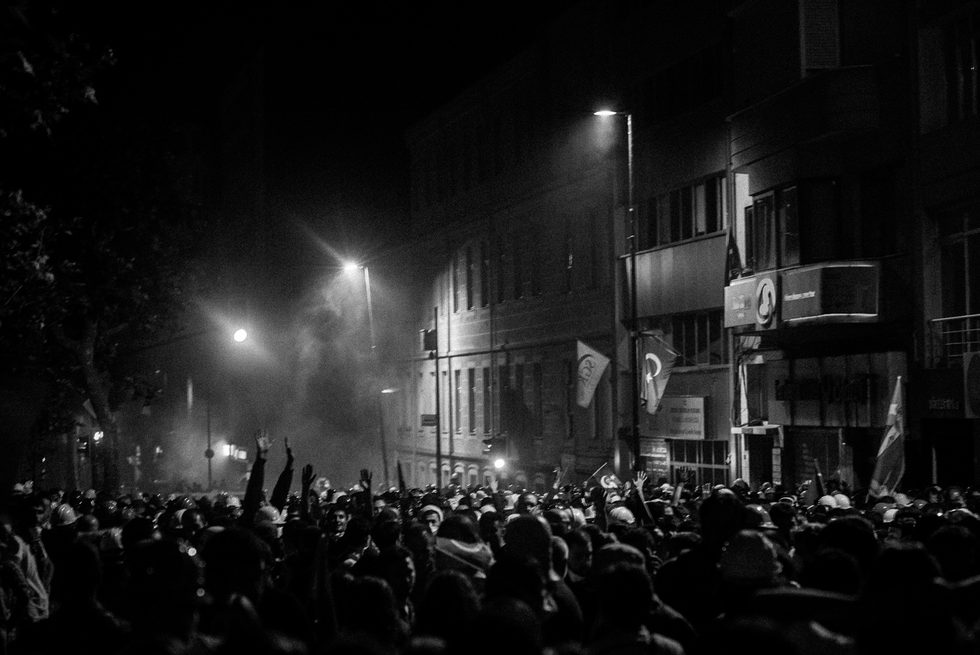The What of Occupation: “You Took Our Cemetery, You Won’t Have Our Park!”
From the Series: An Impromptu Uprising: Ethnographic Reflections on the Gezi Park Protests in Turkey
From the Series: An Impromptu Uprising: Ethnographic Reflections on the Gezi Park Protests in Turkey

Retrospectively, it became a foreboding. Or, in other words, reality came to grimly echo the creative intervention of an Armenian youth group in Gezi Park. Shortly after setting up their association’s tent in the middle of the park during the first days of the occupation, Nor Zartonk stapled together two pieces of grey Styrofoam resembling a gravestone and marked with the line: “You took our cemetery, you won’t have our park!” They then signed this, “Turkey’s Armenians.” A few weeks later, thirteen Armenian gravestones appeared during the surrounding construction works that were meant to eventually encompass Gezi Park itself.
The state apparatus, in its design to restructure Istanbul’s urban space under neoliberal terms, was unintentionally mirroring just what Nor Zartonk was calling attention to: the history of dispossession by the Turkish state. Yet the AKP government dressed its privatization of land in a historical garment, claiming this as a “historically sensitive” reconstruction of Ottoman artillery barracks that would house a future shopping mall. The gravestones that uncannily rose to the surface in the course of construction—“it is flesh and phenomenality that give to the spirit its spectral apparition” (Derrida 1994, 5)—revealed an Armenian cemetery (and the Turkish state’s history of expropriation). The Surp Agop cemetery, which stretched from the north-west of the barracks to today’s TRT building, had been a gift to the community by Sultan Suleyman, grateful for his Armenian cook’s personal loyalty. Immensely valuable property, it was eventually seized by the state in a lengthy legal process in the 1930s. The stones that were not removed by family and community members were used to build Eminönü Square and the stairs of Gezi Park (Polatel et al. 2012, 238–43).
By pointing to what preceded the contemporary struggle against wealth redistribution and for the “commons,” the grey polystyrene formed not only a critique of AKP’s neo-Ottomanism. It also unsettled common perceptions of the park as unmarked green-space. It posed the question of how this public space came into being, asking passersby and co-occupants to face history “with the disjunctive performative force of sheer socio-historical specificity,” thereby rendering “the very conceptual grounds of ‘occupation’ accountable to historical difference and thus to its own material conditions of possibility” (Butler and Athanasiou 2013, 195).
As a performative addition Nor Zartonk’s grey gravestone also evoked the history of dispossession in another sense: its implication in the differential distribution of vulnerability. Passers-by were invited not only to become witnesses of a past and erased landscape of difference, but they were shown writings in an alphabet indigenous to this very landscape, with which most were unfamiliar. Yet, while invisible as a surviving community, Armenians have also been constituted as a hypervisible other within Turkish nationalism. During the occupation, a woman carrying a Turkish flag came with a knife and defaced Nor Zartonk’s large black banner reading “Freedom, Peace, Brotherhood, Equality”; along with other minorities, Armenians became yet again the target of racist hate speech and conspiracy theories.
Despite such reactions, Sayat, a member of the group, exclaimed, “I have never in my life felt safer than behind these barricades. When I see them, I feel something else. . . . We founded a commune here; everything is shared.” It is in this vein that Nor Zartonk’s intervention takes up the challenge “to think of dispossession outside the logic of possession” (Butler and Athanasiou 2013, 7). Precisely because the gravestone is displaced in its geographical accurateness—the cemetery began further up the road—it did not gesture toward reappropriating the space as “Armenian.” By organizing a commemoration for twenty Armenian revolutionaries who were hung in 1915, Nor Zartonk further replaced the original myth of Armenian loyalty to the rulers with a different genealogy of solidarity. To which was added a further anti-nationalist twist with a photo that someone found and attached to the tent: a couple in Chicago protesting with a banner reading “Armenians for ♯occupygezi.” And thus a space opened for a different, relational form of dispossession, a space to be affected by another. Returning to the gravestone and to Sayat’s words:
We experience very emotional moments; people light candles around the grave and pray. . . . There was one guy whose grandparents were buried there and he got very happy to see that gravestone there. People wrote the name of the founder on this makeshift gravestone. Not only Armenians, everyone stopped to think when they saw the stone.
Butler, Judith, and Athena Athanasiou. 2013. Dispossession: The Performative in the Political. Malden, Mass.: Polity Press.
Derrida, Jacques. 1994. Specters of Marx: The State of the Debt, the Work of Mourning, and the New International. Translated by Peggy Kamuf. New York: Routledge.
Polatel, Mehmet, Nora Mildanoğlu, Onat Eren, and Mehmet Atılgan. 2012. 2012 Beyannamesi: İstanbul Ermeni Vakıflarının El Konan Mülkeri. Istanbul: Hrant Dink Vakfı Yayınları.